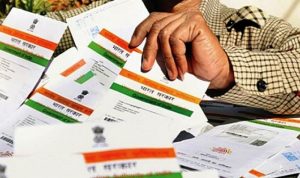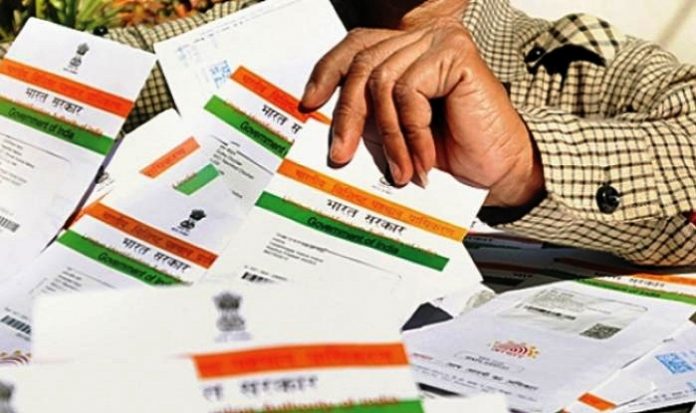
After the long-awaited Padmaavati judgment, the court with a short delay assembled to discuss perhaps one of the most important cases – Aadhaar, the result of which will be a landmark.
The Aadhaar bench reassembled with Mr. Kapil Sibbal, Senior Advocate, mentioning the petition on behalf of the state of West Bengal, challenging Aadhaar. The mentioning was allowed. And the petition was ordered to be heard along with all the other Aadhaar Matters.
With this order, Mr. Shyam Divan, Senior Advocate resumed his set of arguments. His main focus was the following contentions for today :
- Issues related to fundamental rights.
- Is consent involved in Aadhaar Enrolment?
- Issue of enrolling agencies
- Negligible legal framework
- Issue of convergence
- Nexus between right to privacy case and Aadhaar
Mr. Divan said that there are three problems.
- The integrity of the process
- The integrity of the information
- Pervasive violation of the fundamental rights.
He addressed the issue about fundamental rights first. He divided it into three separate issues – privacy, autonomy, and compelled speech.
Mr. Shyam Divan showed the court the Aadhaar enrollment form. He pointed out that Firstly, there is nothing in the form that discloses that it is voluntary. Secondly, there is no mention of bio metrics. Thirdly, there is no verification or declaration.
He then brought the attention of the court to the enrollment form and stated that there is nothing on the form that shows the basis on which its information has been gathered. What was more pertinent to note was that there was no signature. He then raised a question the, “is the consent involved?”
Justice Chandrachud asked at this point whether there is an option to opt out? To which he replied with presenting an affidavit from a person stating that, “he had to get Aadhaar to get married and was told by the operator that he could not opt out.” He then raised a question asking, “How can the State compel anyone to part with anyone with such private information to another individual?” In Mr. Divan’s view, it is one thing to say that the state has set up a scheme and is asking for information. But where is the question of compelling one and give it to another private person?
Mr. Divan argued that The scheme by design is defective.
Justice Chandrchud asked whether it would make any difference if the private party in question is the agent of the state? To which Mr. Divan replied by saying that there is no question of delegating such a core sovereign function to any agency.
Mr. Divan then made a reference to a sting operation where a tv channel went to 3 enrollment agencies, and each of these agencies quoted a figure for revealing demographic information of the people who had enrolled with them. In his words,
“Everything about this process from the beginning to end is unconstitutional.”
Mr. Shyam Divan proceeded to read out the no objection fields from the enrollment form. He stated that there is no counseling even at this stage. UIDAI does not even have privity of contract with the enrollment agencies He continued to read the clause titled “consent,” which is just a declaration by the enrollee that the information he has furnished is correct. It was while the reading he pointed out that the union has not come up with the answer as to how many citizens have said no for further sharing of the information
He then brought to the attention of the court, to the forms of ID requirement to enroll. He raised concerns with the fact that at the time of verification, photocopies of these documents are retained.
Replying to Justice Chandrachud statement that we are always giving private information to private players, such as when getting a mobile connection, Mr. Divan said that “there is no problem per se, with an individual parting individual information. The point here is that we are asked to part information to someone we do not know about. And have no contractual relationship with. The point is that the private party is outside the control of UIDAR and they can use it for their own commercial purposes.”
As per him, the problem is that the process is compromised. And this is what distinguishes it from example the census act.
Moving ahead, Mr. Shyam Divan took the court through the affidavit of Mr. Nachiketa Udupa who was required to enroll with Aadhaar to get married. The software refused to register them when they stated that they were consenting to provide data.The affidavit went ahead to state that UIDAI should allow cancellation of enrollment for those who want to opt out.The affidavit further stated that the then Supreme Court orders were violated with impunity by state authorities.
Mr. Shyam Divan then moved to the statutory form (post act.)
The form said that enrolling in Aadhar is free and voluntary. However, he said that this becomes completely academic if the state were to have it for the purposes of a bank account, PAN card, government scholarships, etc. Mr. Divan informed the bench that RTI reply dated April 2015 revealed that the number of Aadhaar cards generated through the introducer system (used when there was no other form of identity) is 2, 19,000. This is 0.03%. Therefore this shows that a very small percentage of people did not already have a pre-existing id.
Mr. Divan resumed his arguments post lunch with the point regarding the integrity of the process. He categorically stated that his arguments are substantiated by a Rajya Sabha statement that in six years 34,000 operators were blacklisted. These operators tried to pollute the system by making fake Aadhaar cards. He quoted the updated figure as per TOI and ET as 49,000.
He then proceeded to discuss the issue of the registrar and their powers, in the context of a pre-statutory regime on the basis of a UIDAI document – The registrar handbook 2013. He stated that the registrars had been empowered to collect the demographic as well biometric data. The registrars are empowered to retain the data, subject to the fulfillment of their fiduciary responsibilities.
Mr. Divan then explained the concept of a verifier; The verifier is supposed to appointed by the registrars and verify the enrollment documents. Government officials are recommended for this. However, services of an outsourced vendor can also be used. Shyam Divan emphasized that this model obviously did not work. Given that, 49000 enrollment centers have been blacklisted.
It was at this point he explained that enrollment agencies are hired by the registrars. People interacting with the residents are called operators. Their main task is to carry out enrollment.A supervisor is employed to manage the enrollment agencies. The qualifications for these positions is 18+, preferably a graduate/+2 pass, comfortable with computers, preferable to have a prior experience of working at an Aadhaar enrollment center. Which are not enough to be entrusted with such huge responsibilities.
Justice Chandrachud then questioned, “if registrars can be only government agencies?” Mr. Divan replied that there is no such limitation, the registrar can be an independent body as well.
First mention of biometric
Mr. Divan took the court through a MoU between UIDAI and The Government of Delhi. It was a 2010 document, for implementation of the UIDAI program. Under this MoU, UIDAI has the mandated to issue identification based on the demographic and biometric information. The word biometric is seen for the first time in this MoU. Mr. Divan read the document as follows, “The UIDAI will be conducting proof of concept and pilot programs.” “UIDAI shall develop prescribed standards for the biometric fields.”
Mr. Divan pointed to Article 299 of the constitution and stated that MoU is not even a contract as per Article 299. There was absolutely no legal framework to support UIDAI.
As per Mr. Shyam Divan, “This is the palpable lack of integrity in this project for all these years. This denuded the rule of law and eroded governance. That is why you now have a situation of 49000 operators being blacklisted.”
It was here that, Justice Khanwilkar said that the Aadhaar Act, retrospectively validates this. Mr. Divan replied by saying, “you cannot have a retrospective validation of the violation of fundamental rights.”
Mr. Divan explained to the court how the iris scan system was by-passed through a batch in UP and how fingerprints were masked. He further took the court through how the authentication happens via multiple transactions in a day. And took them through the issue of convergence – the linking of the number of services on UID.
Right to privacy judgment and its impact
Mr. Divan finally addressed the privacy judgment by reading out the para 2 of the judgment, thus laying out the background of how the privacy case came into the picture in the first case. He then moved to Para 23 of the judgment, explaining the scope of “right to personal liberty.”
In the words of Mr. Shyam Divan, the procedure for deprivation of these rights must be “just, fair, and reasonable.”
He then discussed how the classic 1899 article on privacy by Warren and Brandeis beautifully explains how in the modern world, the scope of infringement of privacy is far magnified, which is mentioned in para 35 of the judgment.
Mr. Divan referred to para 23, 24, 27, 32, 35, 38 (right to be left alone) of the privacy judgment. Paras 41 through 96 (privacy under Article 21 and part 3 of the Constitution), inalienable rights under 120-121 and relies on 103 and 107 (the rule of law.)
Mr. Divan moved to a state that one of the contentions in their petition is that “in a digitalized world the government has to be an ally of citizens, not it’s adversary. The state must ensure that privacy interests are protected against, say, corporations.”
He pointed to that part of the privacy judgment which articulates the right to personal autonomy and says that decisions affecting an individual’s right are best left to an individual.
Mr. Divan referred to US vs. Jones, an American SC case, which is a part of the privacy judgment. The case dealt with putting a GPS system on the car. Mr. Divan relied on the judgment wherein it was observed that you no longer need physical interference, to violate privacy. Information about an individual’s transactions is enough to give a complete profile of an individual’s rights.
He then relied on the privacy judgment’s articulation on the right to informational self-determination an informational privacy.
Mr. Divan pointed to the part of the privacy judgment that emphasizes that privacy is not just a privilege of the elite. He stressed the importance of judicial review in order to protect an individual right.
The CJI asked Mr. Divan to read the para of the privacy judgment that relates to the age of information (para 306.) This para deals with the issues of data mining and data profiling, especially of major data.
With this, the bench rose. The hearing will now continue on Tuesday at 11:30 AM. For more such updates follow our twitter account, facebook page and of course our blog. Find live updates, most recent information on law and forums which can provide a solution to all your queries. For any doubts reach us at +91 11 3313 8901 or contact us through [email protected]
 Serato DJ Crack 2025Serato DJ PRO Crack
Serato DJ Crack 2025Serato DJ PRO Crack










 Allow notifications
Allow notifications



